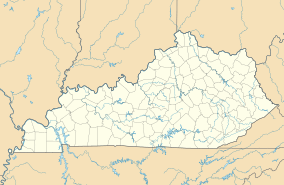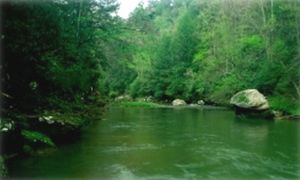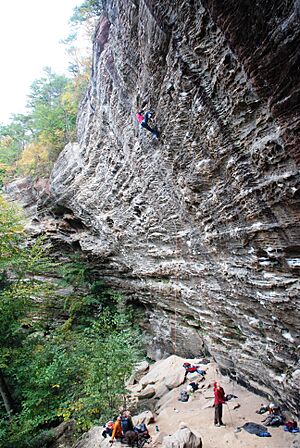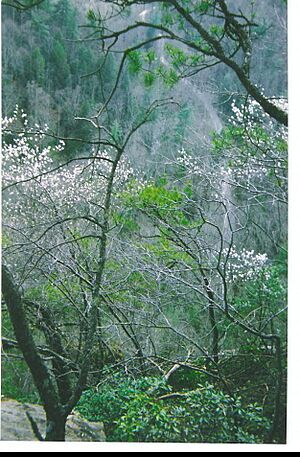Red River Gorge facts for kids
Quick facts for kids Red River Gorge Geological Area |
|
|---|---|
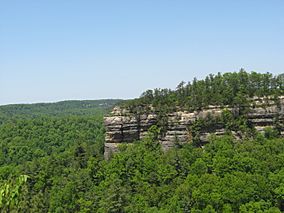
Chimney Top Rock
|
|
| Location | Slade, Kentucky, United States |
| Area | 29,000 acres (120 km2) |
| Established | February 1937 |
| Governing body | United States Forest Service |
| Designated: | 1975 |
The Red River Gorge is a beautiful canyon system in east-central Kentucky. It is part of the Daniel Boone National Forest. This special area is known as the Red River Gorge Geological Area. It covers about 29,000 acres (117 square kilometers).
The Red River Gorge is famous for its many tall sandstone cliffs. You can also find rock shelters, waterfalls, and over 100 natural bridges here. Because of all the sandstone cliffs, it's a top spot for rock climbing. Climbers often call it the Red.
Right next to the gorge is Natural Bridge State Park. This park has one of the biggest natural bridges in the area. The Red River itself, in the upper gorge, is a protected "Kentucky Wild River." This means it's kept in its natural state. The gorge also has many different types of plants and animals.
Contents
History of the Red River Gorge
Nada Tunnel: A Gateway to the Gorge
The Nada Tunnel is a very old logging tunnel. It is 900 feet (274 meters) long, 12 feet (3.7 meters) wide, and 13 feet (4 meters) high. Workers built it between 1910 and 1912. They used dynamite, steam drills, and hand tools to remove rock and dirt. Sadly, one man died during its construction. He tried to thaw frozen dynamite near a fire, and it exploded. Today, the tunnel is often called the "Gateway to Red River Gorge." It offers a shortcut for people driving into the area.
Saving the Red River: No Dam!
For many years, the Red River would flood, causing problems for people living nearby. After a very bad flood in 1962, officials wanted to build a dam to stop future floods. The Army Corps of Engineers started planning the dam.
However, many people worried that a dam would harm the gorge's unique nature. Groups like the Sierra Club fought against the dam. They even got help from Supreme Court Justice William O. Douglas. He joined a protest hike in 1967, which brought a lot of attention to the issue.
In 1971, a Kentucky author named Wendell Berry wrote a book. It was called The Unforeseen Wilderness. This book argued for keeping the gorge natural. The fight to save the gorge lasted for decades. Finally, in 1993, President Bill Clinton signed a law. This law made a 19.4-mile (31.2-kilometer) section of the Red River part of the National Wild and Scenic Rivers System. This stopped any dam from being built and protected the gorge as it is today.
The Red River Gorge in Movies
The Sky Bridge in the Red River Gorge appeared in a movie! It was in the 1955 film The Kentuckian. This movie starred and was directed by Burt Lancaster. It was also the first major movie ever filmed in Kentucky.
Plants and Animals of the Gorge
The Red River Gorge is home to many different kinds of plants and animals. You can find hawks, owls, and woodpeckers flying around. Deer, foxes, and even black bears live here. There are also two types of venomous snakes: the copperhead and the timber rattlesnake.
The gorge is also special because it has some rare plants. One is the white-haired goldenrod, which grows only in the Red River Gorge. Some plants here are from Canada. Scientists believe they arrived during the Ice Age, millions of years ago. These include the purple fringed orchid, Canadian lily, and Canadian yew.
Ancient History and Archaeology
The rock shelters in the Red River Gorge are like time capsules! They hold artifacts from people who lived here long, long ago. Some of these date back to the Paleoindian period, over 11,000 years ago. Rock shelters are great archaeological sites because they protect old items from rain. Things like woven mats and leather moccasins, which would normally rot, are well-preserved here. These sites have even shown some of the earliest signs of plants being grown by people in the eastern United States.
Because of its rich history, the Red River Gorge, along with the Clifty Wilderness and Indian Creek area, became a National Archaeological District in 2003. This means it's a very important historical place.
Clifty Wilderness
Inside the Red River Gorge Geological Area is the Clifty Wilderness. This is a special wilderness area that covers about 13,379 acres (54.1 square kilometers). It is kept wild and natural.
Fun Activities at the Gorge
Rock Climbing: A Climber's Paradise
The Red River Gorge is a world-famous spot for rock climbing. It has many cliffs with bolted routes. Climbers from all over the world come to "the Red" for its unique sandstone. Most climbs are single-pitch, meaning they are not super long. The cliffs are usually less than 200 feet (60 meters) tall. You can find both traditional and sport climbing routes here.
Many climbing spots are in the Daniel Boone National Forest. But some important cliffs are on private land. Two special areas were created to allow climbing:
- Pendergrass-Murray Recreational Preserve is a 750-acre (3 square kilometer) area. The Red River Gorge Climbers' Coalition owns and takes care of it.
- Muir Valley is a 400-acre (1.6 square kilometer) nature preserve and climbing area. It is cared for by Friends of Muir Valley.
Many guidebooks have been written about climbing in the Red River Gorge. These books help climbers find their way and discover new routes.
Hiking and Camping Adventures
The Red River Gorge is also known for its many hiking trails. There are over 60 miles (96 kilometers) of trails! Some are easy for beginners, while others are more challenging. The Forest Service maintains these trails.
You can also go camping in the area. There are many campgrounds. You can even do "primitive camping" (backpack camping) in the gorge. For this, you need an overnight permit. Remember, you can't camp too close to roads or trails. Also, no camping in rock shelters or right at the bottom of cliffs.
One very popular hiking spot is Gray's Arch. It's one of the many natural arches in the park. You can reach it by hiking the Gray's Arch Loop trail, which is 4 miles (6.4 kilometers) long. Some people try to climb up the back of the arch, but this is very dangerous and not recommended.
Gladie Visitor Center
The Daniel Boone National Forest Gladie Visitor Center is located right in the Red River Gorge. It's in Slade, Kentucky. At the center, you can learn about the area's geology, nature, and history. It's a great place to get maps and information about trails, camping, and other fun activities.
Images for kids


